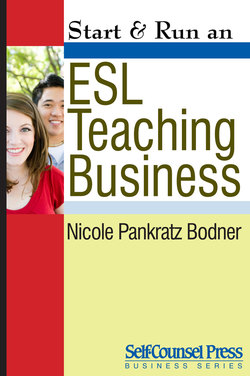Читать книгу Start & Run an ESL Teaching Business - T. Nicole Pankratz - Bodner - Страница 3
На сайте Литреса книга снята с продажи.
ОглавлениеIntroduction
The information in this book is based on my decade and a half of experience working in the English as a Second Language (ESL) industry.
Over the years, I have worn many hats — teacher, tutor, program coordinator, textbook writer, curriculum developer, and teacher trainer. I have worked in large cities and small towns, and in a variety of institutions, large and small, well established and just barely up and running. I have worked with students of all ages from more than 40 countries; students with visual impairment, hearing loss, or physical challenges; and students with unforgettable stories of both hardship and hope. I have worked solo and with teams of professionals, some effective and others less so.
During this time, I have learned that the ESL industry is ideal for people with an entrepreneurial spirit. Although it is related to education, ESL is more about “business” than “school.” Those who do well in the ESL industry understand that in many ways, students are customers who buy products and services — in most cases, English lessons and homestay accommodation — and have certain expectations about their purchases.
Like customers in a store or restaurant, ESL students will complain about products and services they consider unsatisfactory or that are not meeting their expectations. And with a multitude of schools and tutorial services to choose from, dissatisfied students will take their money and their language-acquisition goals elsewhere. For this reason, it is wise for ESL business owners to keep their personal philosophy of education in check — however interesting and profound — and instead focus on getting to know the needs, desires, and perceptions of the students they aim to teach.
Sometimes new business owners with an education or teaching background have trouble understanding their role in the private ESL industry. For example, they may feel it is their obligation to teach international students Western values, or even about life in general. While their intentions may be noble, they often fail to see the big picture or reality of the situation. International students do not come to North America to become Westernized. They may want to learn about Western culture and beliefs, but more often than not, they want to learn English so that they will be able to communicate better with other people about their own culture or belief system. Or they may simply want to prepare for tests that will ultimately lead to a better job, entrance into university, or higher status in their home country.
This book is not for people who have grand ideas about “educating” international students or immigrants. Rather, it is for people who are interested in providing students with the products and services they need, ask for, and are prepared to pay for. It is especially suited to people with some teaching experience and a sincere interest in working with people from other countries.
How the Book Is Organized
This book is divided into four parts. Part 1 contains an overview of the ESL industry in North America. It also provides you with general information on typical ESL schools, tutorial services, and related businesses. The suitability test at the end of the section will help you identify the kind of ESL venture that best suits you.
Part 2 covers the ins and outs of starting an ESL tutorial service. It contains detailed descriptions of what you need to think about and have in place before you start your service, and provides examples from real businesses. At the end of Part 2 you may start making decisions about your business — your target group of students, the kinds of programs you will offer, and where you will run your service. The decisions you make and the information you record can become part of your business plan.
Part 3 is devoted solely to information about ESL schools. At the end of this section you may start to answer key questions necessary for the development of your business plan.
In Part 4, you will start to develop your business plan. This section covers practical topics such as where to find financing, how to name your business, what legal structures to consider, and what you need to get your ESL business off the ground.
How to Use This Book
The best way to use this book is to first read it through entirely and get a feel for the ESL industry and what is involved in starting a tutoring business or a school. Then by revisiting Part 1, you can think about what role you want to play in the industry and decide which type of business best suits your interests and aptitudes. Refer back to either Part 2 (Starting and Running an ESL Tutorial Service) or Part 3 (Starting and Running an ESL School) and get started thinking about what will become part of your business plan.
Taking a second look at Part 4, you can begin to identify some of the things you need to know, find out, and do to make your business legal.
Once you have read the book and worked through the topics, you will be well prepared for the next step — opening the doors of your new business! And chances are, you will be a welcome addition to this exciting industry that promises both financial gain and the opportunity to put to use your creative energy, management skills, and entrepreneurial spirit.
Good luck!
